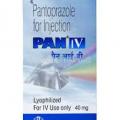Home / Categories / PROTOCID-40MG INJ.

PROTOCID-40MG INJ.
PANTOPRAZOLE INJ.
PROTON PUMP INHIBITORS(PPI)
ACME LABORATORIES LTD
Product Details
Pantoprazole Sodium
Action
Indications
Contraindications
Route/Dosage
Interactions
Lab Test Interferences
Adverse Reactions
PrecautionsPatient Care Considerations
Administration/Storage
Assessment/Interventions
Patient/Family Education
(pahn-TOE-prazz-ole)ProtonixTablets, delayed-release: 40 mgProtonix IVPowder for Injection: 40 mg/vialClass: GI
 Action Suppresses gastric acid secretion by blocking “acid (proton) pump” within gastric parietal cells.
Action Suppresses gastric acid secretion by blocking “acid (proton) pump” within gastric parietal cells.
 Indications
Indications
Oral: Short-term (no more than 8 wk) treatment in the healing and symptomatic relief of erosive esophagitis associated with gastroesophageal reflux disease (GERD); long-term treatment of pathological hypersecretory conditions, including Zollinger-Ellison syndrome; maintenance of healing of erosive esophagitis.
IV: Short-term (7- to 10-day) treatment of GERD, as an alternative to oral therapy in patients unable to continue oral pantoprazole; hypersecretory conditions associated with Zollinger-Ellison syndrome or other neoplastic conditions.
 Contraindications Standard considerations.
Contraindications Standard considerations.
 Route/Dosage
Route/Dosage
Maintenance of Healing of Erosive Esophagitis
Adults: PO 40 mg/day.
Treatment of Erosive Esophagitis
Adults: PO 40 mg/day for up to 8 wk; an additional 8-wk course of treatment may be considered in patients who have not healed after 8 wk. Adults: IV 40 mg/day for 7 to 10 days.
Pathological Hypersecretion Associated with Zollinger-Ellison Syndrome
Adults: IV 80 mg q 12 hr; based upon individual patient needs, the dose may be increased to 80 mg q 8 hr.
 Interactions None well documented.
Interactions None well documented.
 Lab Test Interferences None well documented.
Lab Test Interferences None well documented.
 Adverse Reactions
Adverse Reactions
CARDIOVASCULAR: Angina; arrhythmia; MI; palpitation; chest pain. CNS: Headache; migraine; anxiety; dizziness. DERMATOLOGIC: Rash; erythema multiforme; Stevens-Johnson syndrome; toxic epidermal necrolysis. EENT: Pharyngitis; rhinitis; sinusitis. GI: Diarrhea; flatulence; abdominal pain; constipation; dyspepsia; gastroenteritis; nausea; vomiting. GU: Urinary frequency; UIT. HEPATIC: Abnormal LFTs; increased ALT. RESPIRATORY: Bronchitis; increased cough; dyspnea; upper respiratory tract infection. OTHER: Asthenia; back pain; neck pain; flu syndrome; pain; arthralgia; hypertonia.
 Precautions
Precautions
Pregnancy: Category B. Lactation: Undetermined. Children: Safety and efficacy not established.
PATIENT CARE CONSIDERATIONS
 Administration/Storage
Administration/Storage
- Give oral preparation once daily without regard to meals.
- Do not split, chew, or crush. Instruct patient to swallow tablet whole.
- IV preparation is only used when patient cannot take tablets and for no more than 10 days.
- Reconstitute IV preparation with 10 mL of 0.9% Sodium Chloride Injection, then further dilute by mixing with 100 mL of 0.9% Sodium Chloride Injection, 5% Dextrose Injection, or Lactated Ringer's Injection.
- Administer IV preparation once daily by infusing over a period of about 15 min through a dedicated line using the in-line filter provided. If administered through a Y-site, the in-line filter must be positioned below the Y-site that is closest to the patient.
- The in-line filter removes precipitates that may form when the reconstituted drug product is mixed with recommended IV solutions but does not reduce the total amount of drug administered.
- Flush IV line before and after administration with 5% Dextrose Injection, 0.9% Sodium Chloride Injection, or Lactated Ringer's Injection.
- Do not simultaneously administer IV pantoprazole through the same line with other IV solutions.
- Store tablets at controlled room temperature. Store powder for injection in refrigerator, protected from light. Reconstituted solution may be stored for up to 2 hr at room temperature before further dilution. The diluted solution may be stored for up to 12 hr at room temperature before infusion. Reconstituted and diluted solutions do not need to be protected from light. Store in-line filters at room temperature.
 Assessment/Interventions
Assessment/Interventions
- Obtain patient history, including drug history and any known allergies. Note history of liver disease.
- Assess for bloody or coffee ground emesis and black tarry stools.
- Assess for symptoms of esophageal reflux (eg, heart burn, acid regurgitation) or peptic ulcer activity (eg, indigestion, abdominal pain, nausea).
 Patient/Family Education
Patient/Family Education
- Explain name, dose, action, and potential side effects of drug.
- Advise patient to not split, crush, or chew medication and to swallow the tablet whole.
- Remind patient to take dose once daily without regard to meals.
- Inform patient that antacids may be taken concurrently with pantoprazole.
- Remind patient that pantoprazole is to be taken every day and not “as needed” or only when symptoms are present.
- Instruct women to notify health care provider if pregnant, planning to become pregnant, or breastfeeding.
- Advise patient to report any of the following to the health care provider: bloody or coffee ground emesis; black tarry stools; recurrent heart burn; recurrent indigestion or abdominal pain; increasing need for antacid use.
Books@Ovid
Copyright © 2003 Facts and Comparisons
David S. Tatro
A to Z Drug Facts

